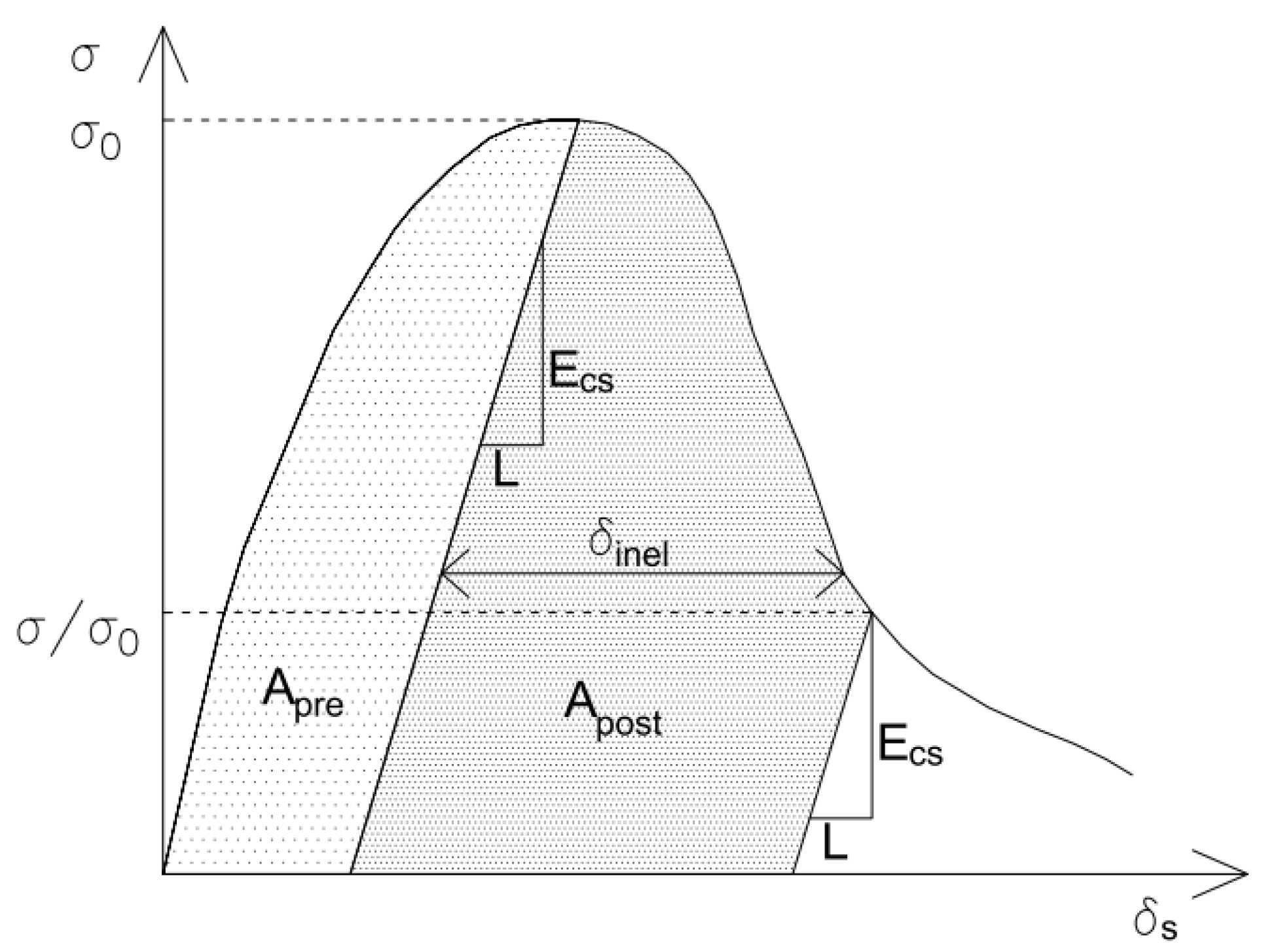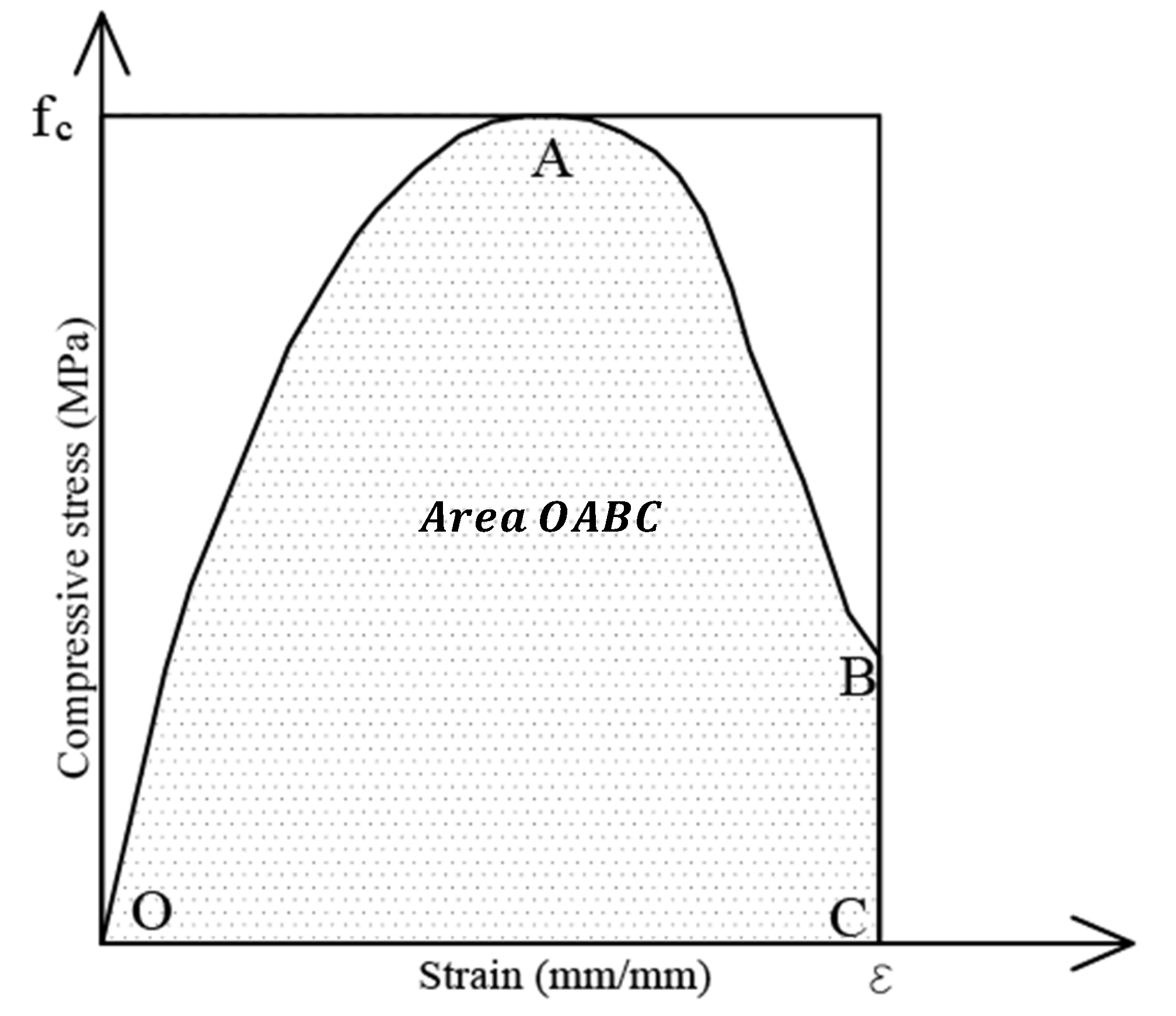Toughness of Natural Hydraulic Lime Fibre-Reinforced Mortars for Masonry Strengthening Overlay Systems
Abstract
1. Introduction
Research Significance
2. Materials and Methods
2.1. Materials
2.2. Mixing Process and Fresh State
2.3. Hardened State
3. Results
3.1. Fresh Behaviour
3.2. Hardened Behaviour
3.2.1. Compression Tests Results
3.2.2. Flexural Test Results
4. Discussion of Results
4.1. Compressive Behaviour
4.2. Flexural Behaviour
4.3. Toughness in Compression
4.4. Toughness in Flexure
4.5. Fibre Reinforcement Efficiency in Flexure
4.5.1. Contribution for Flexural Strength
4.5.2. Contribution for Flexural Toughness
5. Conclusions
- The inclusion of PAN fibres in an NHL matrix changed the fresh and hardened behaviour of the mortar, even with minimal fibre addition of 0.25%.
- A fibre content of 1.00% resulted in deficient workability for overlay application. Utilizing admixtures like superplasticizers may enhance workability without compromising mechanical properties.
- The target values of compressive strength at 28 days, 10 < fc < 15 MPa, were achieved for F0.50_RH60 and F0.75_RH60 and for all mortars cured at RH85.
- The flexural strength target values, 5 < fft,fl < 7.5 MPa, were achieved for F0.75_RH85, F1.00_RH60 and F1.00_RH85.
- The compressive and flexural toughness of the FRM substantially increase with the adding of fibres. There was an important variation in the capacity to dissipate energy, even for lower amounts as 0.25%; this capacity was maximized at 1.00% of fibres.
- The correlation between the mechanical properties in compression and flexure and the respective toughness ratios showed opposite trends. While the toughness ratio in compression increased for lower compressive strength values, the toughness ratio in flexure increased for higher flexural strength values.
Author Contributions
Funding
Institutional Review Board Statement
Informed Consent Statement
Data Availability Statement
Acknowledgments
Conflicts of Interest
References
- Gautam, D.; Chaulagain, H. Structural performance and associated lessons to be learned from world earthquakes in Nepal after 25 April 2015 (MW 7.8) Gorkha earthquake. Eng. Fail. Anal. 2016, 68, 222–243. [Google Scholar] [CrossRef]
- Parisi, F.; Augenti, N. Earthquake damages to cultural heritage constructions and simplified assessment of artworks. Eng. Fail. Anal. 2013, 34, 735–760. [Google Scholar] [CrossRef]
- Romão, X.; Costa, A.; Paupério, E.; Rodrigues, H.; Vicente, R.; Varum, H. Field observations and interpretation of the structural performance of constructions after the 11 May 2011 Lorca earthquake. Eng. Fail. Anal. 2013, 34, 670–692. [Google Scholar] [CrossRef]
- De Felice, G.; De Santis, S.; Garmendia, L.; Ghiassi, B.; Larrinaga, P.; Lourenco, P.; Oliveira, D.; Paolacci, F.; Papanicolaou, C.G. Mortar-based systems for externally bonded strengthening of masonry. Mater. Struct. 2014, 47, 2021–2037. [Google Scholar] [CrossRef]
- García, D.; Díez, J. Stone masonry walls: Strengthening with TRM (I). In Structural Analysis of Historic Construction; Ayala, D.F.D., Fodde, E., Eds.; Taylor & Francis Group: London, UK, 2008; pp. 851–859. [Google Scholar]
- Garmendia, L.; Larrinaga, P.; García, D.; Marcos, I. Textile-reinforced mortar as strengthening material for masonry arches. Int. J. Arch. Heritage 2014, 8, 627–648. [Google Scholar] [CrossRef]
- Kouris, L.A.S.; Triantafillou, T.C. State-of-the-art on strengthening of masonry structures with textile reinforced mortar (TRM). Constr. Build. Mater. 2018, 188, 1221–1233. [Google Scholar] [CrossRef]
- De Felice, G.; Aiello, M.A.; Caggegi, C.; Ceroni, F.; De Santis, S.; Garbin, E.; Gattesco, N.; Hojdys, Ł.; Krajewski, P.; Kwiecień, A.; et al. Recommendation of RILEM Technical Committee 250-CSM: Test method for Textile Reinforced Mortar to substrate bond characterization. Mater. Struct. 2018, 51, 95. [Google Scholar] [CrossRef]
- Bakis, C.E.; Bank, L.C.; Brown, V.L.; Cosenza, E.; Davalos, J.F.; Lesko, J.J.; Machida, A.; Rizkalla, S.H.; Triantafillou, T.C. Fiber-Reinforced Polymer Composites for Construction—State-of-the-Art Review. J. Compos. Constr. 2002, 6, 73–87. [Google Scholar] [CrossRef]
- Papanicolaou, C.; Triantafillou, T.; Lekka, M. Externally bonded grids as strengthening and seismic retrofitting materials of masonry panels. Constr. Build. Mater. 2011, 25, 504–514. [Google Scholar] [CrossRef]
- Almeida, J.A.; Pereira, E.B.; Barros, J.A. Assessment of overlay masonry strengthening system under in-plane monotonic and cyclic loading using the diagonal tensile test. Constr. Build. Mater. 2015, 94, 851–865. [Google Scholar] [CrossRef]
- Kyriakides, M.A.; Billington, S.L. Seismic Retrofit of Masonry-Infilled Non-Ductile Reinforced Concrete Frames Using Sprayable Ductile Fiber-Reinforced Cementitious Composites. In Proceedings of the 14 World Conference on Earthquake Engineering, Beijing, China, 12–17 October 2008. [Google Scholar]
- Dehghani, A.; Fischer, G.; Alahi, F.N. Strengthening masonry infill panels using engineered cementitious composites. Mater. Struct. 2013, 48, 185–204. [Google Scholar] [CrossRef]
- Stefanidou, M.; Papayianni, I.; Pachta, V. Evaluation of inclusions in mortars of different historical periods from greek monuments. Archaeometry 2012, 54, 737–751. [Google Scholar] [CrossRef]
- Mansur, M.; Aziz, M. A study of jute fibre reinforced cement composites. Int. J. Cem. Compos. Light. Concr. 1982, 4, 75–82. [Google Scholar] [CrossRef]
- Filho, R.D.T.; Scrivener, K.; England, G.L.; Ghavami, K. Durability of alkali-sensitive sisal and coconut fibres in cement mortar composites. Cem. Concr. Compos. 2000, 22, 127–143. [Google Scholar] [CrossRef]
- Claramunt, J.; Ardanuy, M.; García-Hortal, J.A.; Filho, R.D.T. The hornification of vegetable fibers to improve the durability of cement mortar composites. Cem. Concr. Compos. 2011, 33, 586–595. [Google Scholar] [CrossRef]
- Fidelis, M.E.A.; Filho, R.D.T.; Silva, F.d.A.; Mechtcherine, V.; Butler, M.; Hempel, S. The effect of accelerated aging on the interface of jute textile reinforced concrete. Cem. Concr. Compos. 2016, 74, 7–15. [Google Scholar] [CrossRef]
- Kim, D.J.; Naaman, A.E.; El-Tawil, S. Comparative flexural behavior of four fiber reinforced cementitious composites. Cem. Concr. Compos. 2008, 30, 917–928. [Google Scholar] [CrossRef]
- Ralegaonkar, R.; Gavali, H.; Aswath, P.; Abolmaali, S. Application of chopped basalt fibers in reinforced mortar: A review. Constr. Build. Mater. 2018, 164, 589–602. [Google Scholar] [CrossRef]
- Skourup, B.N.; Erdogmus, E. Characteristics of PVA fiber-reinforced mortars. In Proceedings of the 2009 Structures Congress—Don’t Mess with Structural Engineers: Expanding Our Role, Austin, TX, USA, 30 April–2 May 2009; Leslie, E., Ed.; Robertson Associates: New York, NY, USA, 2009; pp. 1622–1631. [Google Scholar]
- Silva, B.; Pinto, A.F.; Gomes, A. Natural hydraulic lime versus cement for blended lime mortars for restoration works. Constr. Build. Mater. 2015, 94, 346–360. [Google Scholar] [CrossRef]
- Pavía, S.; Hanley, R. Flexural bond strength of natural hydraulic lime mortar and clay brick. Mater. Struct. 2010, 43, 913–922. [Google Scholar] [CrossRef]
- Pozo-Antonio, J. Evolution of mechanical properties and drying shrinkage in lime-based and lime cement-based mortars with pure limestone aggregate. Constr. Build. Mater. 2015, 77, 472–478. [Google Scholar] [CrossRef]
- Kalagri, A.; Karatasios, I.; Kilikoglou, V. The effect of aggregate size and type of binder on microstructure and mechanical properties of NHL mortars. Constr. Build. Mater. 2014, 53, 467–474. [Google Scholar] [CrossRef]
- Gulotta, D.; Goidanich, S.; Tedeschi, C.; Toniolo, L. Commercial NHL-containing mortars for the preservation of historical architecture. Part 2: Durability to salt decay. Constr. Build. Mater. 2015, 96, 198–208. [Google Scholar] [CrossRef]
- Aly, M.; Pavia, S. Mechanical and hygric properties of natural hydraulic lime (NHL) mortars with pozzolans. In Proceedings of the SMAR 2015—Third Conference on Smart Monitoring, Assessment and Rehabilitation of Civil Structures, Antalaya, Turkey, 7–9 September 2015; ITÜ, Istanbul Technical University: Antalaya, Turkey, 2015. [Google Scholar]
- Sadrmomtazi, A.; Tahmouresi, B.; Saradar, A. Effects of silica fume on mechanical strength and microstructure of basalt fiber reinforced cementitious composites (BFRCC). Constr. Build. Mater. 2018, 162, 321–333. [Google Scholar] [CrossRef]
- Dawood, E.T.; Mohammad, Y.Z.; Abbas, W.A.; Mannan, M.A. Toughness, elasticity and physical properties for the evaluation of foamed concrete reinforced with hybrid fibers. Heliyon 2018, 4, e01103. [Google Scholar] [CrossRef]
- Dawood, E.T.; Ramli, M. Properties of High-Strength Flowable Mortar Reinforced with Palm Fibers. ISRN Civ. Eng. 2012. [Google Scholar] [CrossRef]
- Deng, Z.C.; Deng, H.L.; Li, J.H.; Liu, G.D. Flexural fatigue behavior and performance characteristics of polyacrylonitrile fiber reinforced concrete. Key Eng. Mater. 2006, 302–303, 572–583. [Google Scholar] [CrossRef]
- Xu, F.; Zhou, M.K.; Shen, W.G.; Li, B.X. Study on the toughness performance of polypropylene fiber and sbr polymer latex modified cement mortar. Adv. Mater. Res. 2009, 79–82, 1751–1754. [Google Scholar] [CrossRef]
- Al-Mashhadani, M.M.; Canpolat, O.; Aygörmez, Y.; Uysal, M.; Erdem, S. Mechanical and microstructural characterization of fiber reinforced fly ash based geopolymer composites. Constr. Build. Mater. 2018, 167, 505–513. [Google Scholar] [CrossRef]
- Kheradmand, M.; Mastali, M.; Abdollahnejad, Z.; Pacheco-Torgal, F. Experimental and numerical investigations on the flexural performance of geopolymers reinforced with short hybrid polymeric fibres. Compos. Part B Eng. 2017, 126, 108–118. [Google Scholar] [CrossRef]
- De Oliveira, L.A.P.; Castro-Gomes, J.P. Physical and mechanical behaviour of recycled PET fibre reinforced mortar. Constr. Build. Mater. 2011, 25, 1712–1717. [Google Scholar] [CrossRef]
- Chan, R.; Bindiganavile, V. Toughness of fibre reinforced hydraulic lime mortar. Part-1: Quasi-static response. Mater. Struct. 2010, 43, 1435–1444. [Google Scholar] [CrossRef]
- Iucolano, F.; Liguori, B.; Colella, C. Fibre-reinforced lime-based mortars: A possible resource for ancient masonry restoration. Constr. Build. Mater. 2013, 38, 785–789. [Google Scholar] [CrossRef]
- Liguori, B.; Caputo, D.; Iucolano, F. Fiber-reinforced lime-based mortars: Effect of zeolite addition. Constr. Build. Mater. 2015, 77, 455–460. [Google Scholar] [CrossRef]
- Seker, B.S.; Cakir, F.; Acar, V.; Seydibeyoglu, M.O.; Akbulut, H. Combined effects of chopped carbon and glass fibres on mechanical properties of lime-based mortar. Adv. Compos. Lett. 2017, 26, 41–48. [Google Scholar] [CrossRef]
- Asprone, D.; Cadoni, E.; Iucolano, F.; Prota, A. Analysis of the strain-rate behavior of a basalt fiber reinforced natural hydraulic mortar. Cem. Concr. Compos. 2014, 53, 52–58. [Google Scholar] [CrossRef]
- Santarelli, M.L.; Sbardella, F.; Zuena, M.; Tirillò, J.; Sarasini, F. Basalt fiber reinforced natural hydraulic lime mortars: A potential bio-based material for restoration. Mater. Des. 2014, 63, 398–406. [Google Scholar] [CrossRef]
- Almeida, J.A.; Bordigoni, D.; Pereira, E.B.; Barros, J.A.; Aprile, A. Assessment of the properties to characterise the interface between clay brick substrate and strengthening mortar. Constr. Build. Mater. 2016, 103, 47–66. [Google Scholar] [CrossRef][Green Version]
- Asteris, P.G.; Argyropoulos, I.; Cavaleri, L.; Rodrigues, H.; Varum, H.; Thomas, J.; Lourenço, P.B. Masonry compressive strength prediction using artificial neural networks. In Transdisciplinary Multispectral Modeling and Cooperation for the Preservation of Cultural Heritage; Communications in Computer and Information Science; Springer: Cham, Switzerland, 2019. [Google Scholar] [CrossRef]
- Zahra, T.; Dhanasekar, M. Prediction of masonry compressive behaviour using a damage mechanics inspired modelling method. Constr. Build. Mater. 2016, 109, 128–138. [Google Scholar] [CrossRef]
- EN 1015-3:1999; Methods of Test for Mortar for Masonry—Part 3: Determination of Consistence of Fresh Mortar (by Flow Table). Comité Européen de Normalisation: Brussels, Belgium, 2004.
- EN 1015-7:1999; Methods of Test for Mortar for Masonry—Part 7: Determination of Air Content of Fresh Mortar. Comité Européen de Normalisation: Brussels, Belgium, 2004.
- EN 459-1:2010; Building Lime—Part 1: Definitions, Specifications and Conformity Criteria. Comité Européen de Normalisation: Brussels, Belgium, 2010.
- EN 197-1:2011; Cement. Composition, Specifications and Conformity Criteria for Common Cements. Comité Européen de Normalisation: Brussels, Belgium, 2011; pp. 1–50.
- EN 13139:2013; Aggregates for Mortar. Comité Européen de Normalisation: Brussels, Belgium, 2013.
- EN 196-1:2005; Methods of Testing Cement—Part 1: Determination of Strength. Comité Européen de Normalisation: Brussels, Belgium, 2005.
- EN 1015-10:1999; Methods of Test for Mortar for Masonry—Part 10: Determination of Dry Bulk Density of Hardened Mortar. Comité Européen de Normalisation: Brussels, Belgium, 2006.
- EN 12390-13:2013; Testing Hardened Concrete. Part 13: Determination of Secant Modulus of Elasticity in Compression. Comité Européen de Normalisation: Brussels, Belgium, 2013.
- EN 1015-11:1999; Methods of Test Mortar for Masonry—Part 11: Determination of Flexural and Compressive Strength of Hardened Mortar. Comité Européen de Normalisation: Brussels, Belgium, 1999.
- González, D.C.; Rahman, M.; Mínguez, J.; Vicente, M.A.; Hindi, R. Influence of fibers and curing conditions on the pore morphology in plain and fiber-reinforced high-performance concrete through the use of computed tomography scan technology. Appl. Sci. 2020, 10, 4286. [Google Scholar] [CrossRef]
- Lanas, J.; Bernal, J.P.; Bello, M.; Galindo, J.A. Mechanical properties of natural hydraulic lime-based mortars. Cem. Concr. Res. 2004, 34, 2191–2201. [Google Scholar] [CrossRef]
- Jang, S.-J.; Yun, H.-D. Combined effects of steel fiber and coarse aggregate size on the compressive and flexural toughness of high-strength concrete. Compos. Struct. 2018, 185, 203–211. [Google Scholar] [CrossRef]
- Naaman, A.E.; Reinhardt, H.W. High Performance Fiber Reinforced Cement Composites HPFRCC-4: International RILEM Workshop. Mater. Struct. 2003, 36, 710–712. [Google Scholar] [CrossRef]
- Rilem TC 49-TFR. Test for the determination of modulus of rupture and limit of proportionality of thin fibre reinforced cement section. Mater Struct. 1984, 17, 161–163. [Google Scholar]
- Jansen, D.C.; Shah, S.P.; Jansen, M.D.C.; Member, A. Effect of Length on Compressive Strain Softening of Concrete. J. Eng. Mech. 1997, 123, 25–35. [Google Scholar] [CrossRef]
- Vasconcelos, G. Experimental Investigations on the Mechanics of Stone Masonry: Characterization of Granites and Behavior of Ancient Masonry Shear Walls. Ph.D. Dissertation, University of Minho, Braga, Portugal, 2005. [Google Scholar]
- Nataraja, M.; Dhang, N.; Gupta, A. Stress–strain curves for steel-fiber reinforced concrete under compression. Cem. Concr. Compos. 1999, 21, 383–390. [Google Scholar] [CrossRef]
- Bhargava, P.; Sharma, U.K.; Kaushik, S.K. Compressive Stress-Strain Behavior of Small Scale Steel Fibre Reinforced High Strength Concrete Cylinders. J. Adv. Concr. Technol. 2006, 4, 109–121. [Google Scholar] [CrossRef][Green Version]
- EN 1992-1-1:2004; Eurocode 2: Design of Concrete Structures—Part 1-1: General Rules and Rules for Buildings. CEN: Brussels, Belgium, 2004.
- Banthia, N.; Mindess, S. Toughness Characterization of Fiber-Reinforced Concrete: Which Standard to Use? J. Test. Evaluation 2004, 32, 11901. [Google Scholar] [CrossRef]
- JSCE. JSCE-SF4 Method of Tests for Flexural Strength and Flexural Toughness of Steel Fiber Reinforced Concrete; JSCE: Tokyo, Japan, 1984. [Google Scholar]
- Pakravan, H.R.; Jamshidi, M.; Latifi, M. Performance of fibers embedded in a cementitious matrix. J. Appl. Polym. Sci. 2010, 116, 1247–1253. [Google Scholar] [CrossRef]
- ASTM C1018-97; Standard Test Method for Flexural Toughness and First-Crack Strength of Fiber-Reinforced Concrete (Using Beam with Third-Point Loading). American Society for Testing and Materials: West Conshohocken, PA, USA, 1997. [CrossRef]
- ASTM C1609; Standard Test Method for Flexural Performance of Fiber-Reinforced Concrete (Using Beam with Third-Point Loading). American Society for Testing and Materials: West Conshohocken, PA, USA, 2012; pp. 1–9.
- C1399/C1399M; Standard Test Method for Obtaining Average Residual-Strength of Fiber-Reinforced. American Society for Testing and Materials: West Conshohocken, PA, USA, 2010; pp. 1–6. [CrossRef]
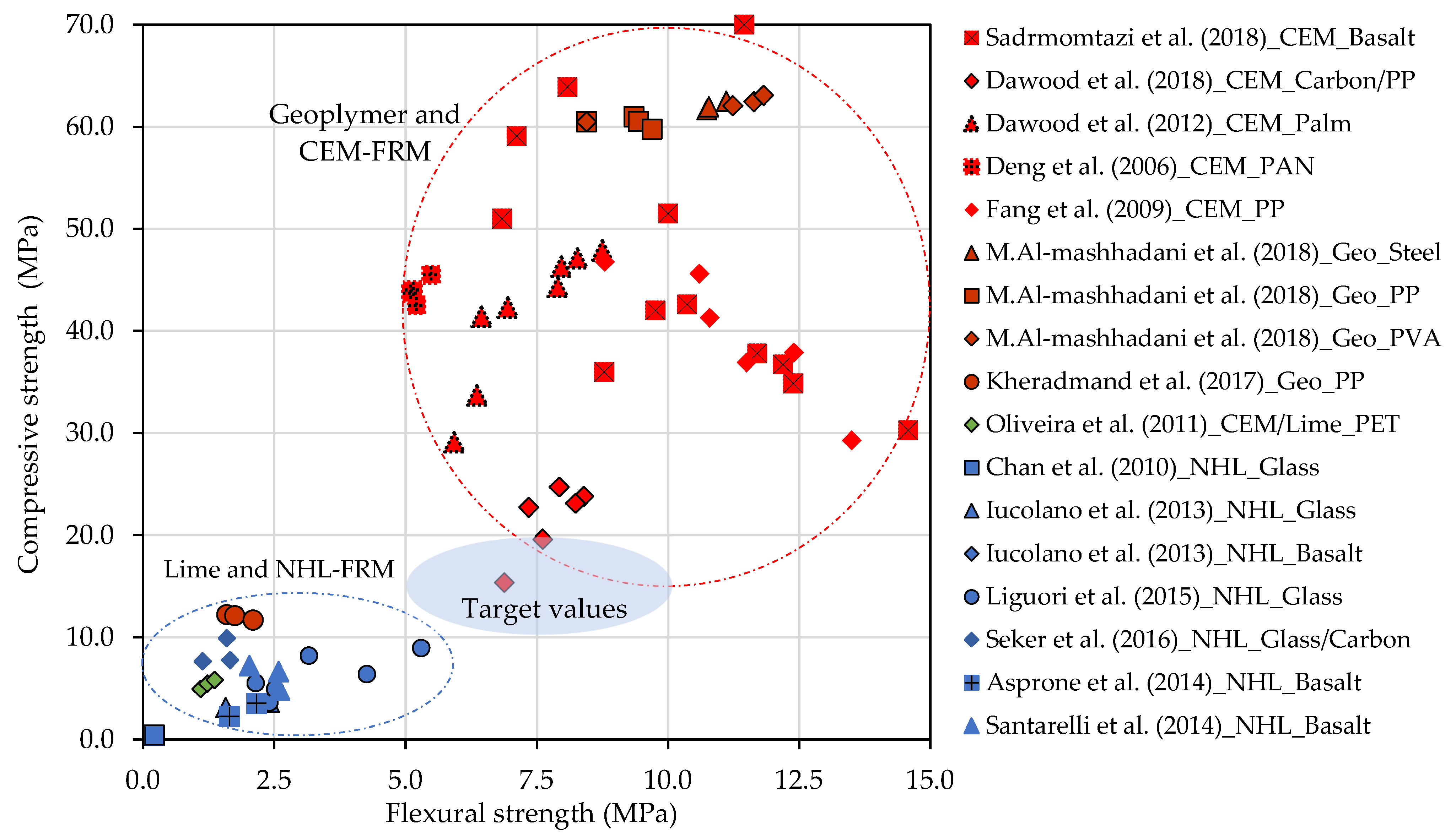
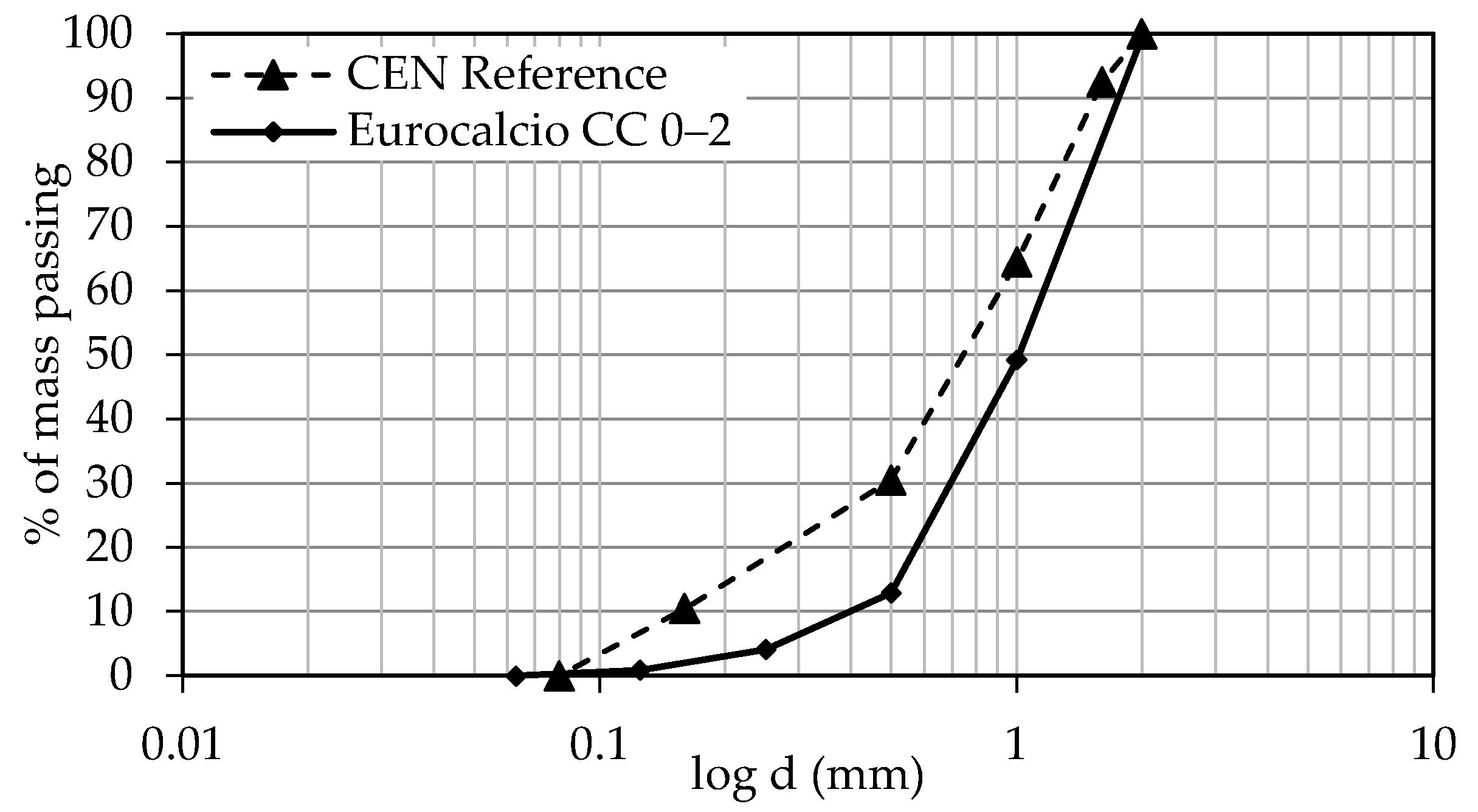

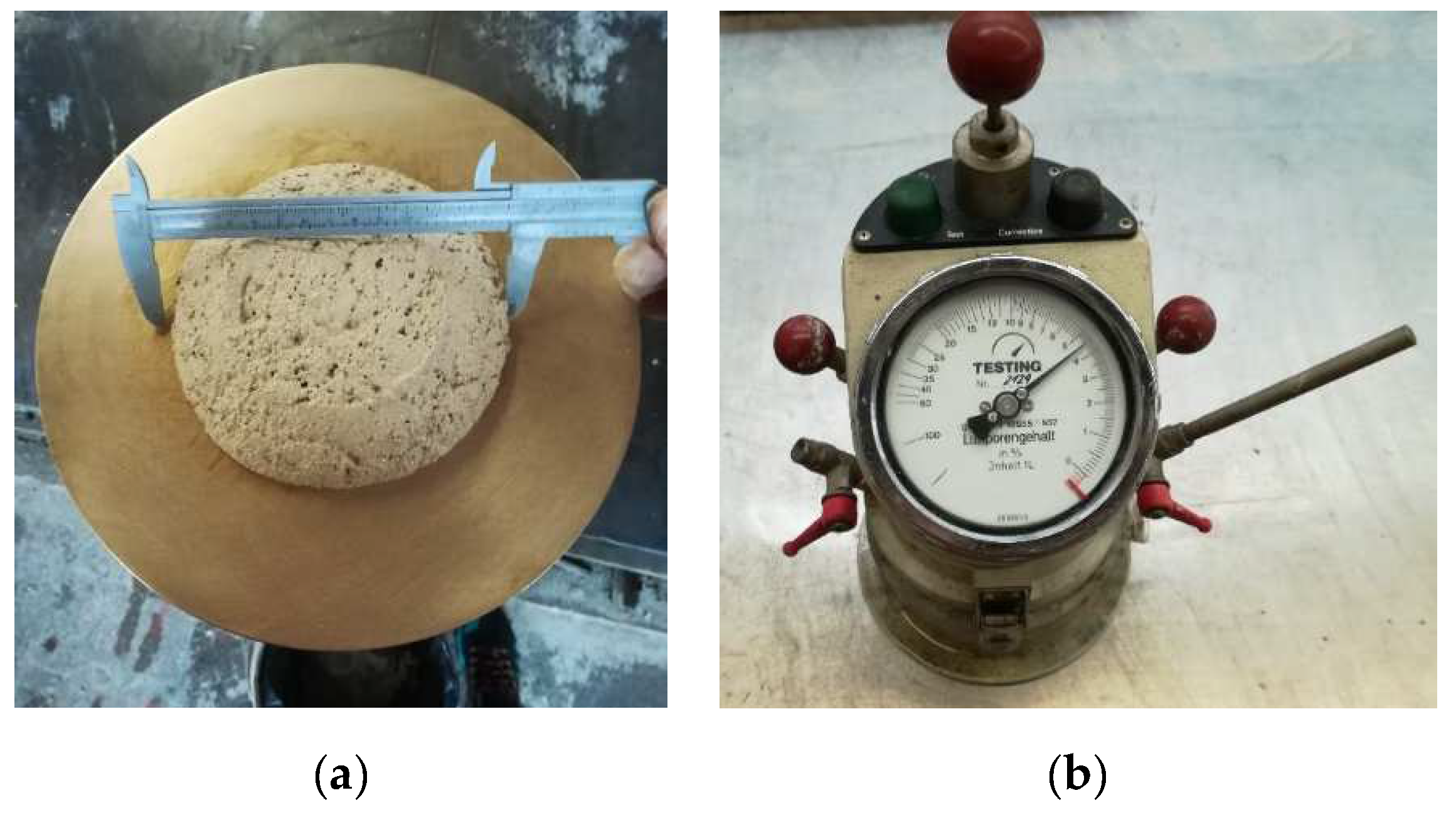


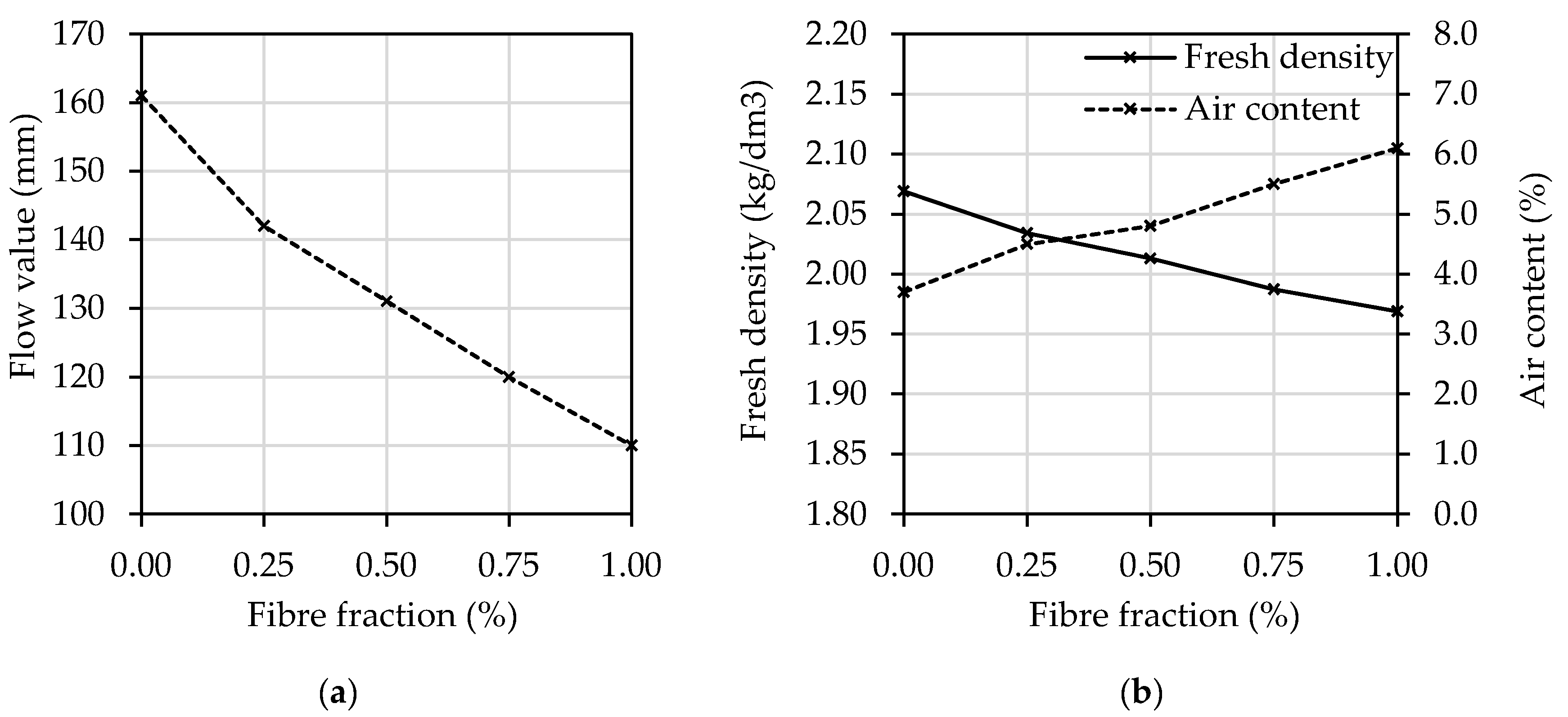
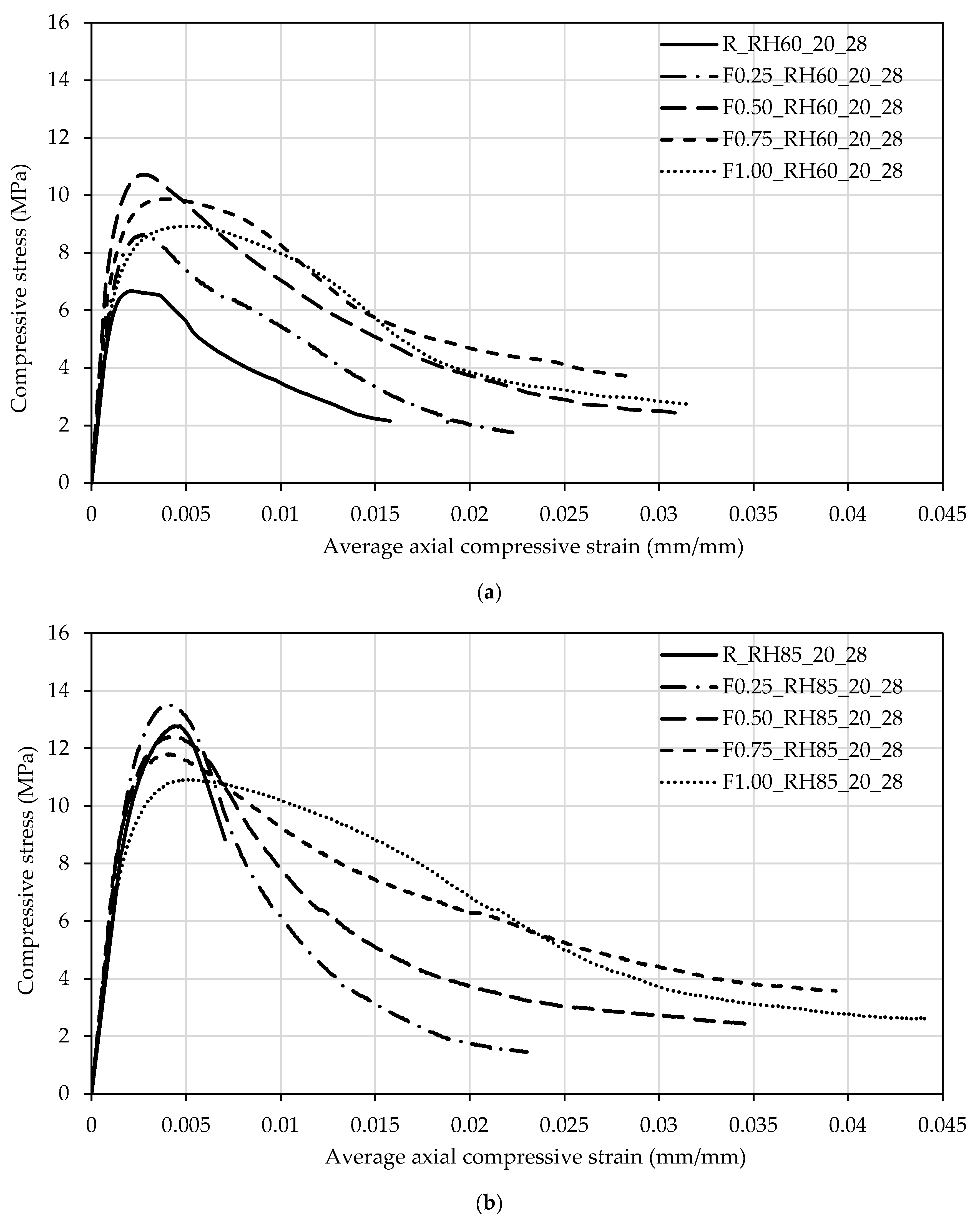
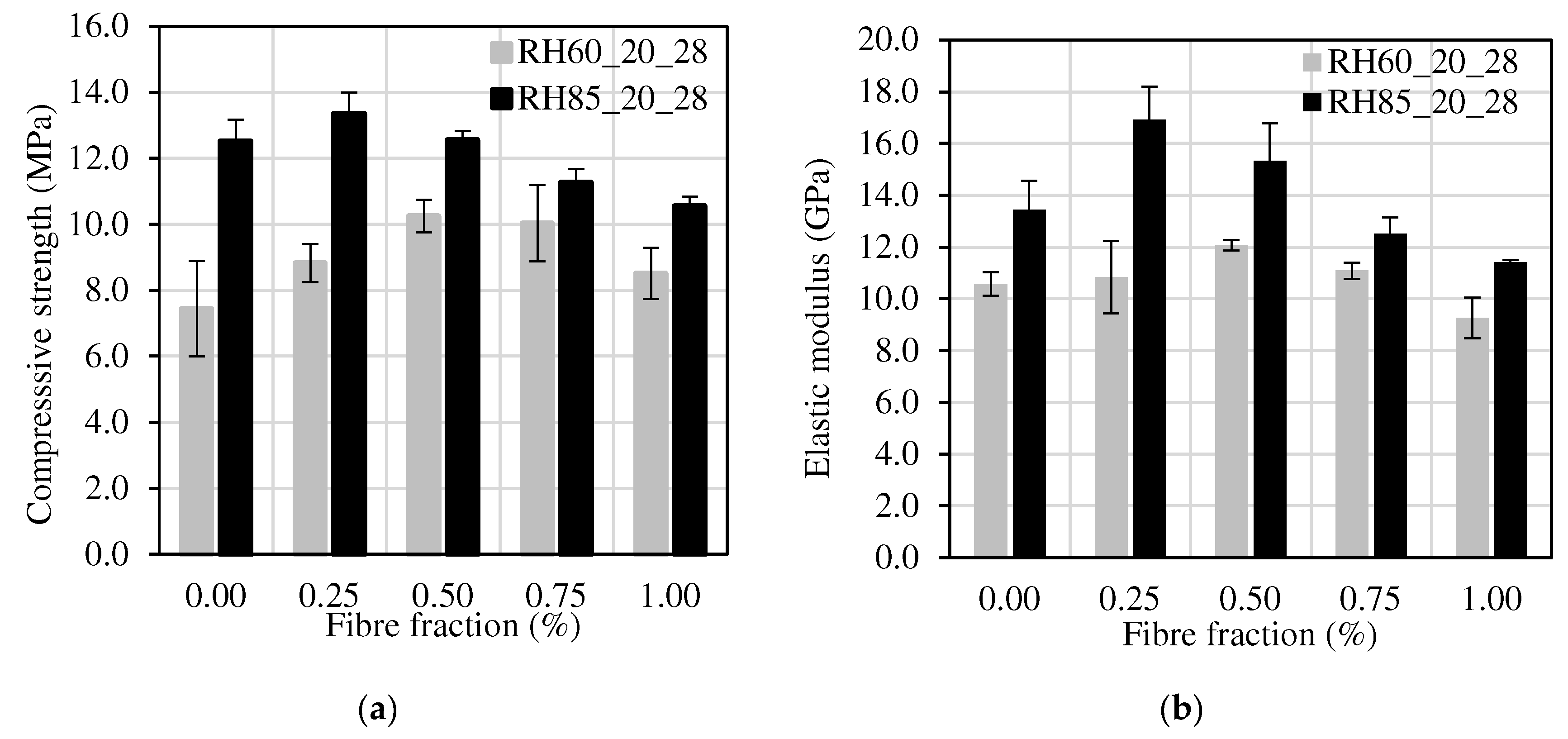




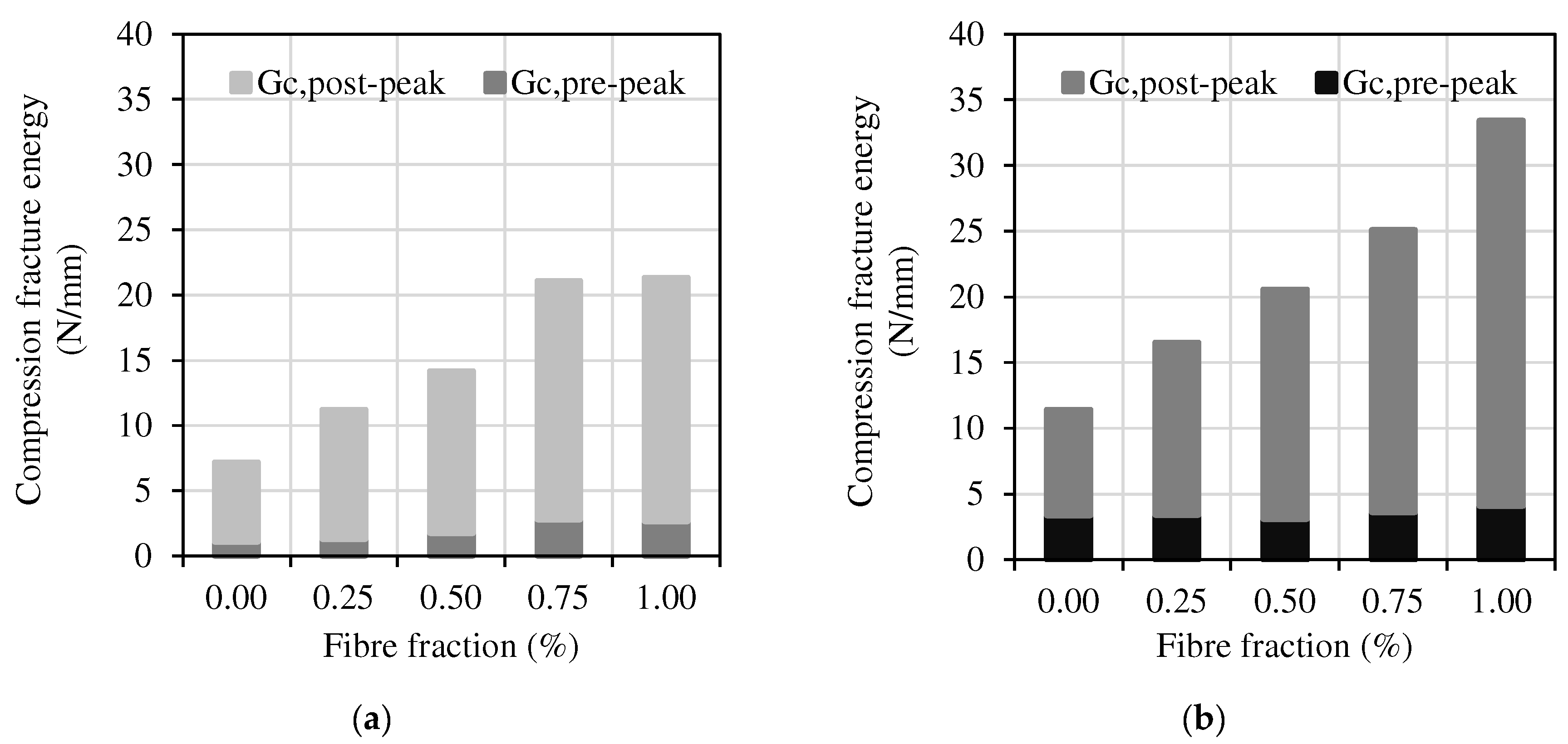
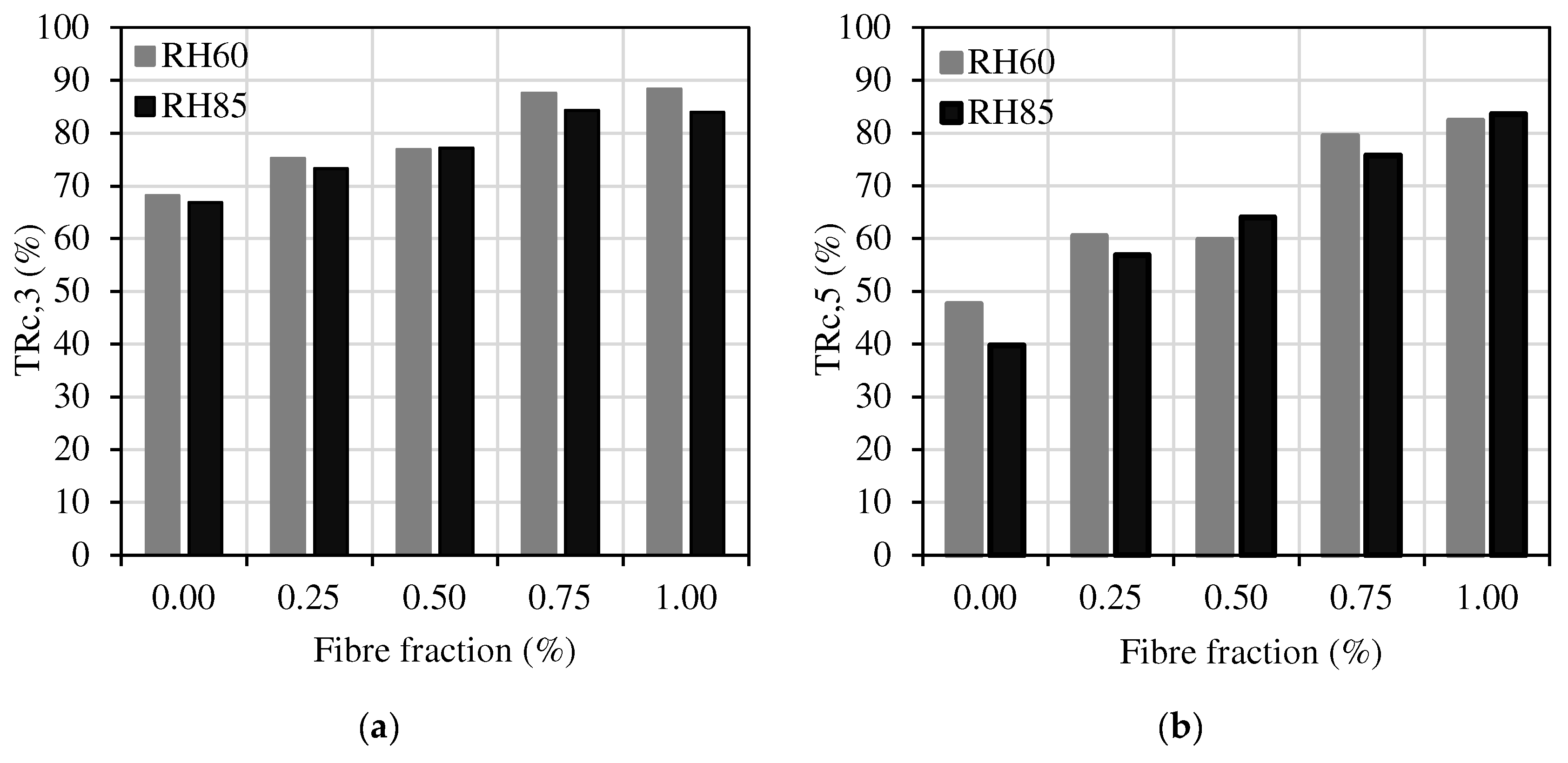
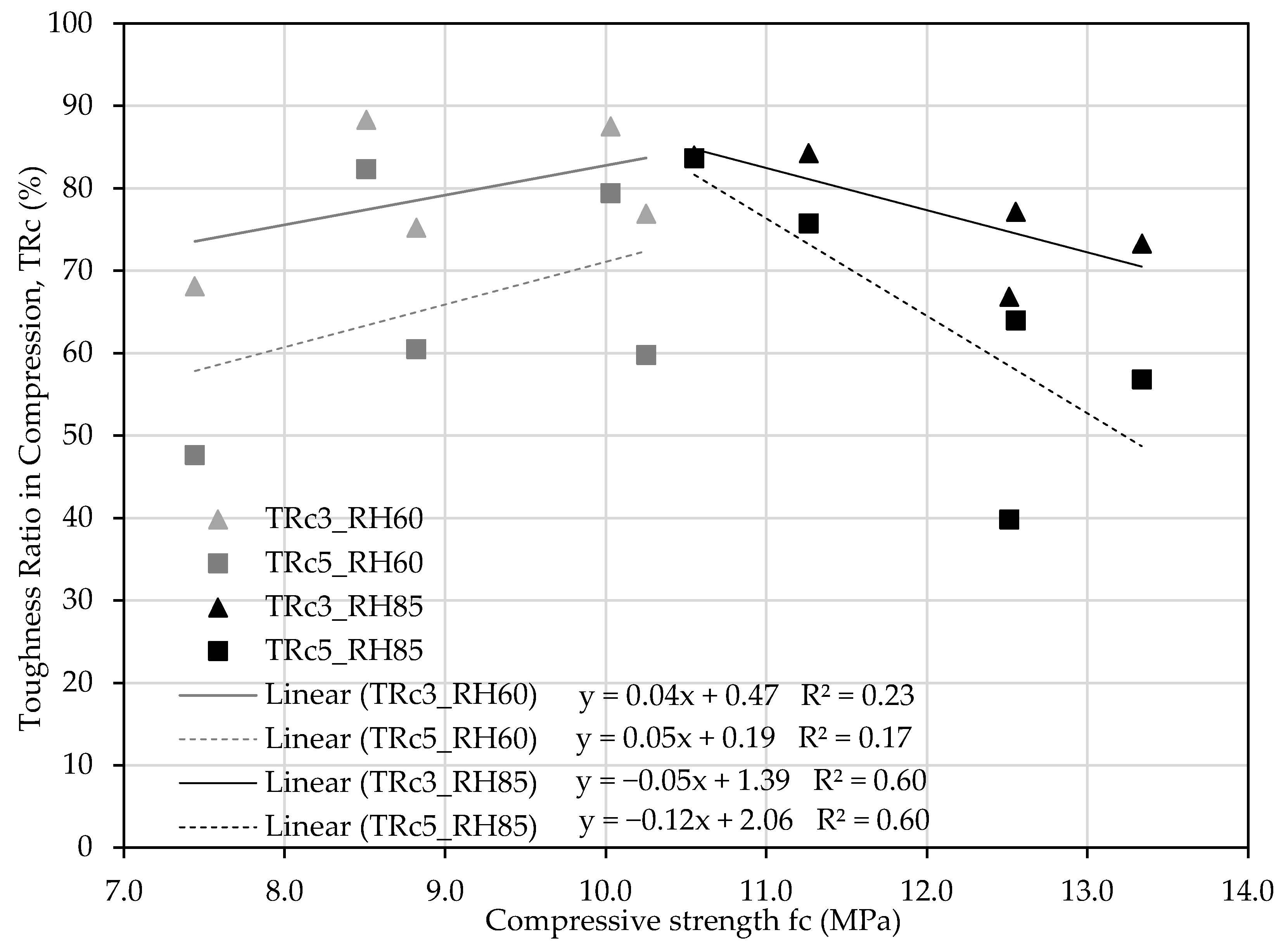

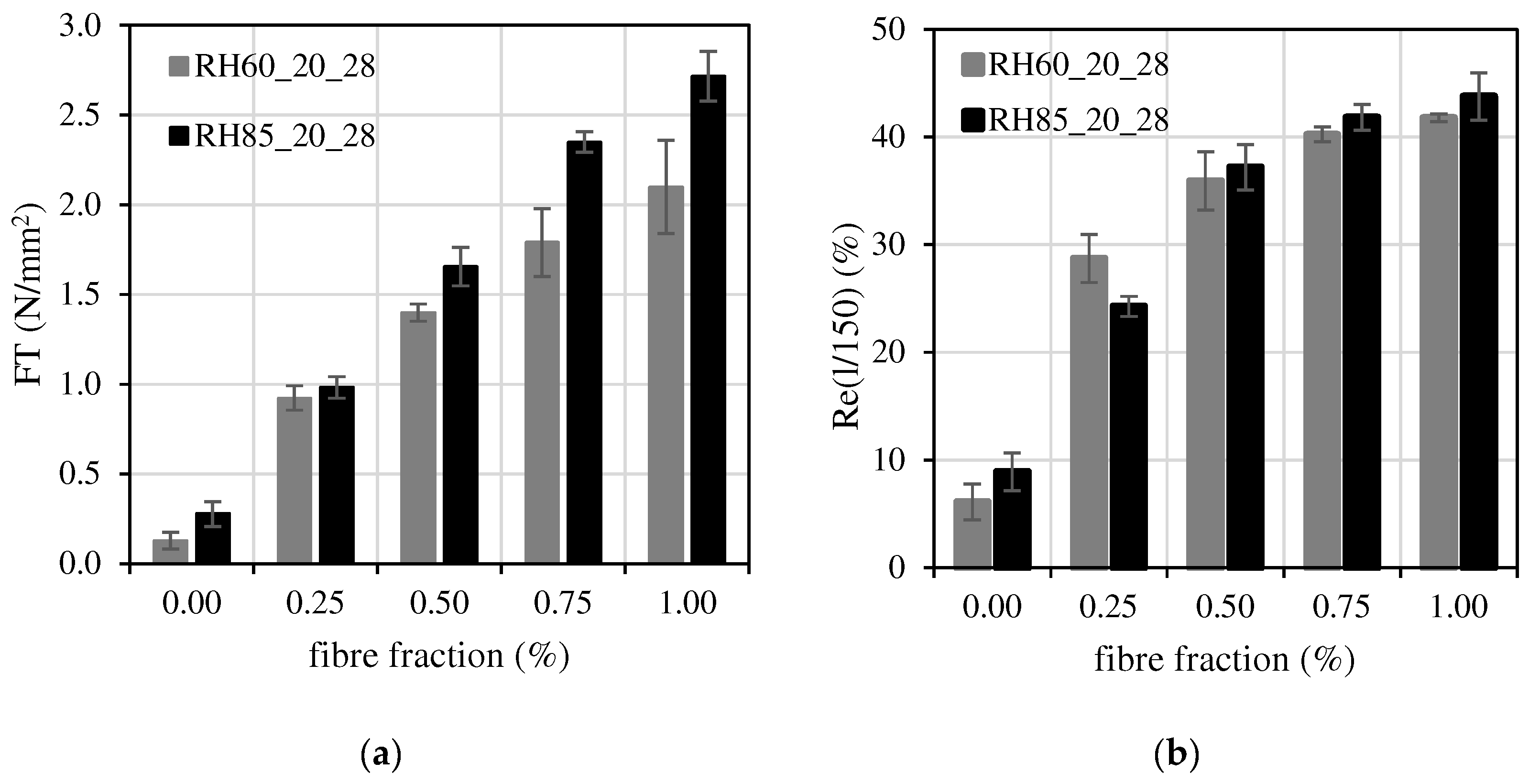
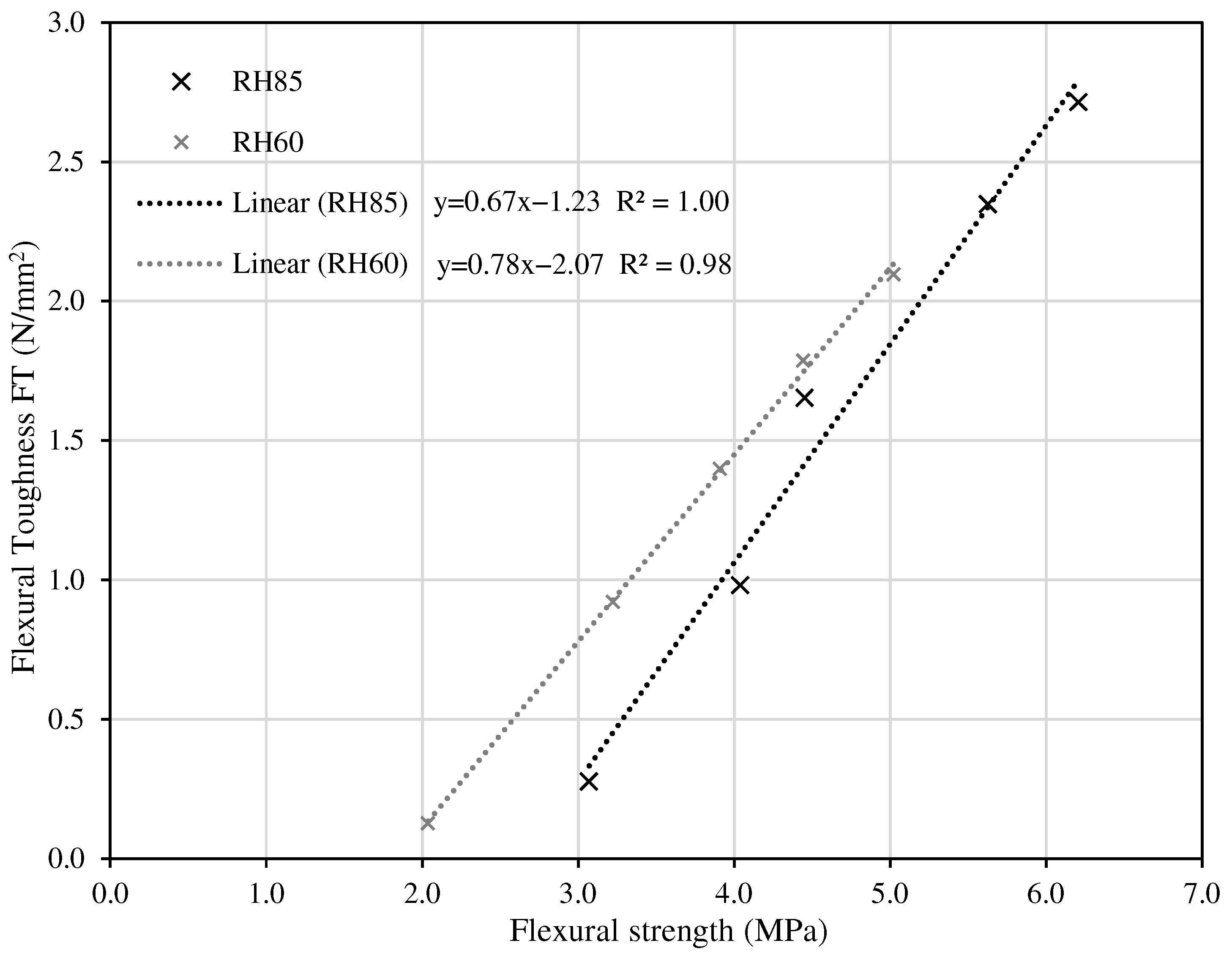
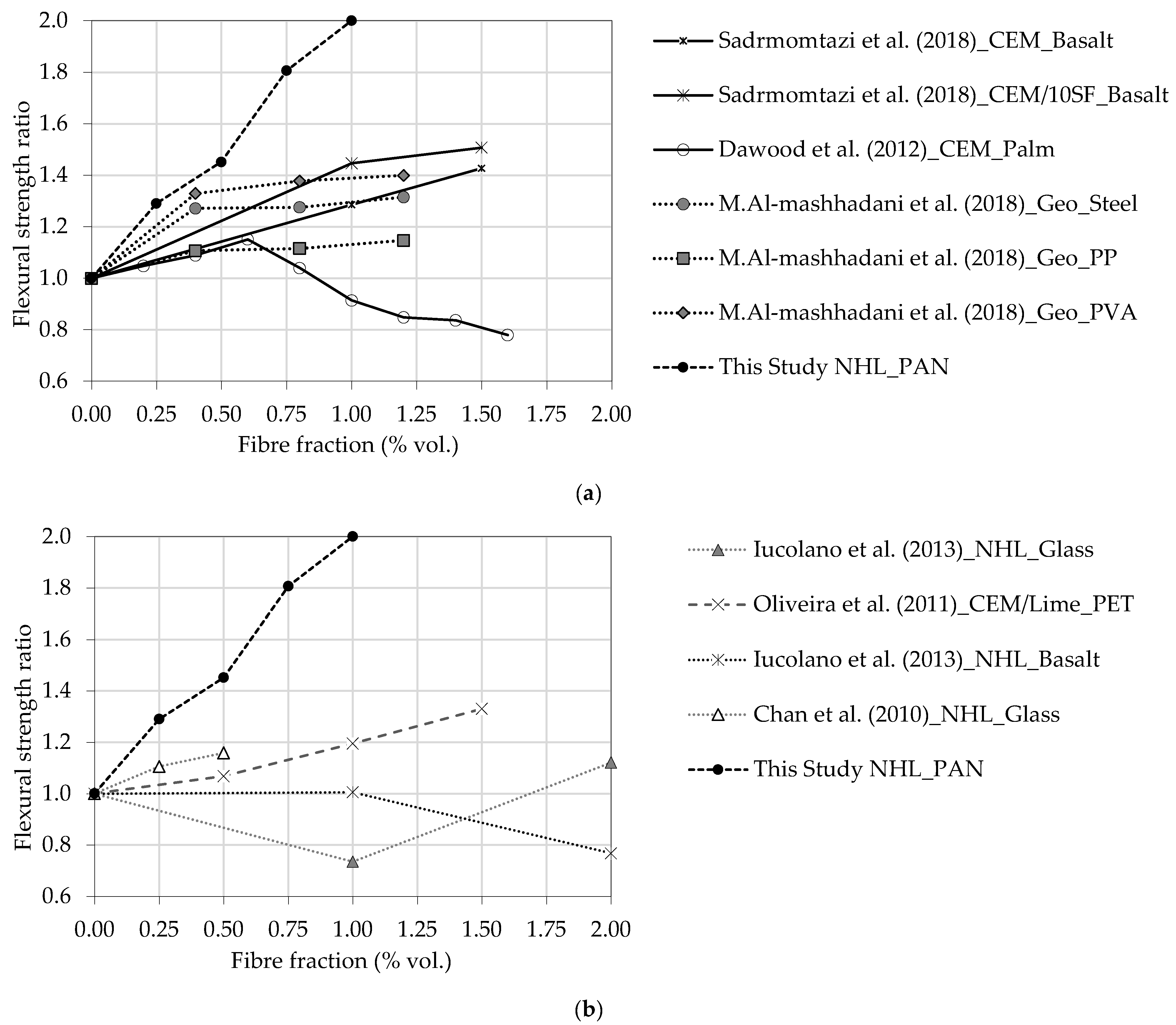
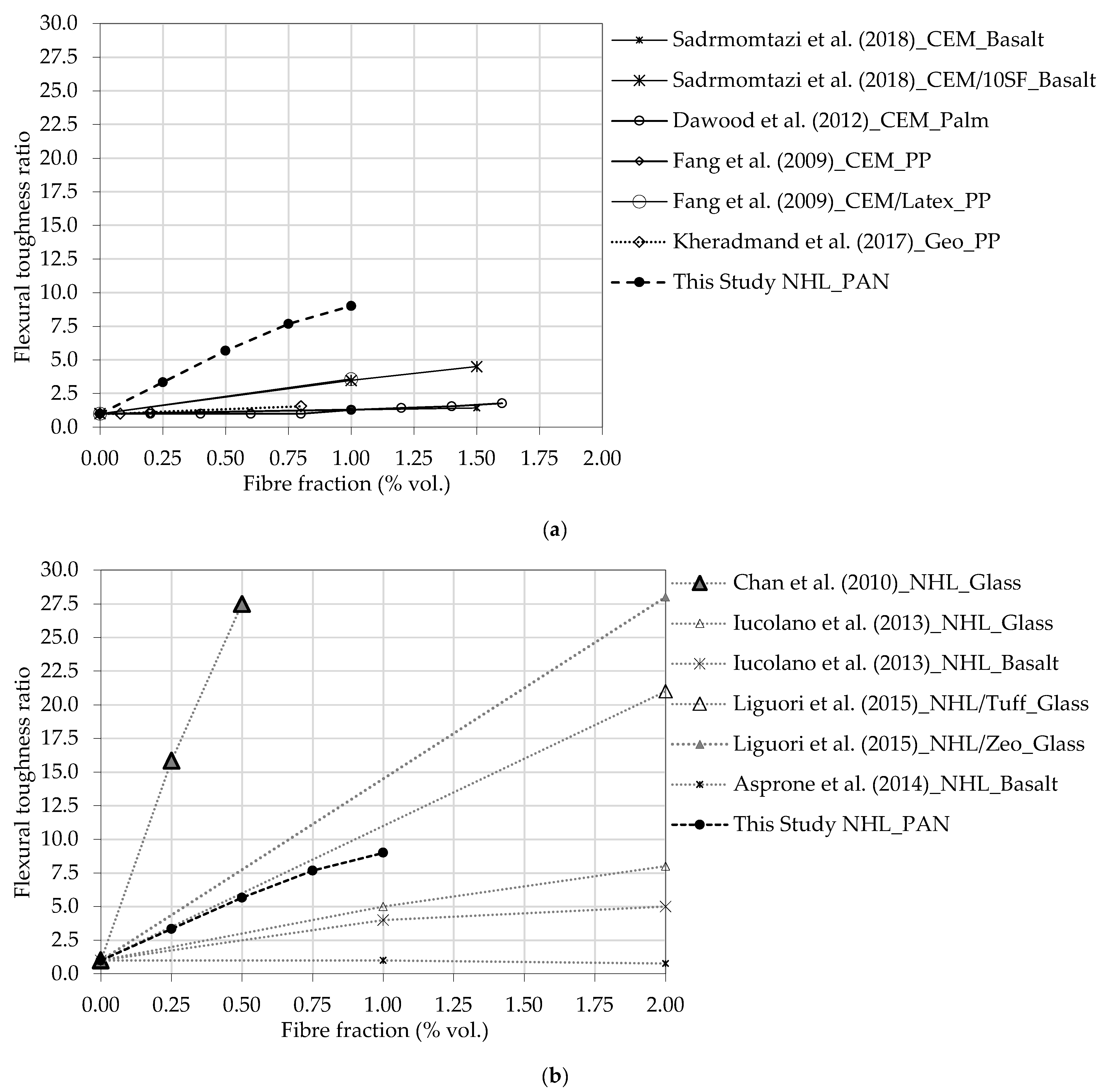
| Physical Properties | ||
|---|---|---|
| Fineness (>90 µm) | (%) | ≤15.0 |
| Fineness (>200 µm) | (%) | ≤2.0 |
| Setting time, start | (hour) | >1 |
| Setting time, final | (hour) | ≤15 |
| Chemical Properties | ||
| (Sulphate) SO3 | (%) | ≤2 |
| (Free Lime) Ca(OH)2 | (%) | ≥15 |
| (Anhydrite) CaSO4 | (%) | <1 |
| Mechanical Properties | ||
| Compressive strength at 7 days | (MPa) | ≥2 |
| Compressive strength at 28 days | (MPa) | ≥5.0 and ≤15.0 |
| Density | (g/cm3) | 1.17 |
| Length | (mm) | 6 |
| Fineness | (dtex) | 2.5 |
| Tensile strength | (MPa) | 580 |
| Elongation | (%) | 14–18 |
| Elastic Modulus | (GPa) | 10.4 |
| vol. (%) | Weight of Components (kg/m3) | |||||
|---|---|---|---|---|---|---|
| Mixture | Fibres | NHL 5.0 | CEM Br. | Sand | Water | PAN Fibres |
| R | 0.00% | 663.9 | 66.4 | 995.9 | 328.6 | 0.0 |
| F_0.25 | 0.25% | 662.2 | 66.2 | 993.3 | 327.8 | 2.9 |
| F_0.50 | 0.50% | 660.4 | 66.0 | 990.6 | 326.9 | 5.9 |
| F_0.75 | 0.75% | 658.7 | 65.9 | 988.0 | 326.0 | 8.8 |
| F_1.00 | 1.00% | 656.9 | 65.7 | 985.4 | 325.2 | 11.7 |
| RH60_20_28 | RH85_20_28 | |||||||
|---|---|---|---|---|---|---|---|---|
| Specimen | (MPa) | MPa (%) | (mm/mm) | mm/mm (%) | (MPa) | MPa (%) | (mm/mm) | mm/mm (%) |
| R_01 | 5.8 | 0.002 | 12.8 | 0.005 | ||||
| R_02 | 8.9 | 0.003 | 13.2 | 0.006 | ||||
| R_03 | 8.3 | 0.002 | 11.7 | 0.004 | ||||
| R_04 | 6.7 | 7.4 (17) | 0.002 | 0.002 (16) | 12.4 | 12.5 (5) | 0.004 | 0.005 (15) |
| F0.25_01 | 9.3 | 0.002 | 13.5 | 0.004 | ||||
| F0.25_02 | 9.2 | 0.002 | 13.3 | 0.004 | ||||
| F0.25_03 | 8.6 | 0.003 | 14.1 | 0.004 | ||||
| F0.25_04 | 8.1 | 8.8 (6) | 0.002 | 0.002 (9) | 12.5 | 13.3 (4) | 0.004 | 0.004 (7) |
| F0.50_01 | 9.6 | 0.003 | 12.3 | 0.003 | ||||
| F0.50_02 | 10.7 | 0.003 | 12.6 | 0.004 | ||||
| F0.50_03 | 10.2 | 0.003 | 12.4 | 0.004 | ||||
| F0.50_04 | 10.5 | 10.2 (4) | 0.003 | 0.003 (3) | 12.9 | 12.6 (2) | 0.003 | 0.004 (7) |
| F0.75_01 | 8.5 | 0.004 | 11.3 | 0.004 | ||||
| F0.75_02 | 10.9 | 0.004 | 11.8 | 0.004 | ||||
| F0.75_03 | 9.9 | 0.004 | 11.2 | 0.004 | ||||
| F0.75_04 | 10.9 | 10 (10) | 0.004 | 0.004 (4) | 10.8 | 11.3 (3) | 0.005 | 0.004 (12) |
| F1.00_01 | 9.2 | 0.004 | 10.6 | 0.008 | ||||
| F1.00_02 | 7.4 | 0.003 | 10.3 | 0.006 | ||||
| F1.00_03 | 8.9 | 0.005 | 10.3 | 0.004 | ||||
| F1.00_04 | 8.5 | 8.5 (8) | 0.005 | 0.004 (22) | 10.9 | 10.5 (2) | 0.005 | 0.006 (20) |
| RH85_20 | RH60_20_28 | |||||||||
|---|---|---|---|---|---|---|---|---|---|---|
| 7 Days | 28 Days | 90 Days | 28 Days | 90 Days | ||||||
| Specimen | MPa (%) | mm (%) | MPa (%) | mm (%) | MPa (%) | mm (%) | MPa (%) | mm (%) | MPa (%) | mm (%) |
| R_01 | 2.02 | 0.16 | 2.78 | 0.12 | 3.91 | 0.12 | 2.02 | 0.16 | 2.49 | 0.17 |
| R_02 | 2.02 | 0.15 | 3.18 | 0.19 | 4.19 | 0.13 | 2.02 | 0.15 | 2.21 | 0.12 |
| R_03 | 2.57 | 0.18 | 3.25 | 0.18 | 3.5 | 0.11 | 2.57 | 0.18 | 2.5 | 0.11 |
| 2.2 (12) | 0.16 (8) | 3.07 (7) | 0.16 (19) | 3.87 (7) | 0.12 (7) | 2.2 (12) | 0.16 (8) | 2.40 (6) | 0.13 (17) | |
| F0.25_01 | 1.92 | 0.11 | 4.14 | 0.21 | 4.4 | 0.15 | 1.92 | 0.11 | 2.97 | 0.12 |
| F0.25_02 | 1.88 | 0.15 | 3.88 | 0.14 | 4.75 | 0.16 | 1.88 | 0.15 | 3.16 | 0.14 |
| F0.25_03 | 2.05 | 0.17 | 4.1 | 0.15 | 3.95 | 0.14 | 2.05 | 0.17 | 3.71 | 0.16 |
| 1.95 (4) | 0.14 (16) | 4.04 (3) | 0.17 (17) | 4.37 (7) | 0.15 (6) | 1.95 (4) | 0.14 (16) | 3.28 (9) | 0.14 (10) | |
| F0.50_01 | 3.26 | 0.42 | 4.67 | 0.25 | 5.12 | 0.18 | 3.26 | 0.42 | 4.1 | 0.15 |
| F0.50_02 | 2.92 | 0.44 | 4.23 | 0.19 | 4.81 | 0.18 | 2.92 | 0.44 | 4.8 | 0.16 |
| F0.50_03 | 2.63 | 0.37 | 4.46 | 0.28 | 4.43 | 0.16 | 2.63 | 0.37 | 4.62 | 0.15 |
| 2.94 (9) | 0.41 (7) | 4.45 (4) | 0.24 (17) | 4.79 (6) | 0.17 (8) | 2.94 (9) | 0.41 (7) | 4.50 (7) | 0.15 (4) | |
| F0.75_01 | 3.56 | 0.38 | 6.06 | 0.32 | 5.87 | 0.29 | 3.56 | 0.38 | 5 | 0.16 |
| F0.75_02 | 3.35 | 0.35 | 5.41 | 0.36 | 5.37 | 0.28 | 3.35 | 0.35 | 5.45 | 0.28 |
| F0.75_03 | 3.37 | 0.43 | 5.41 | 0.34 | 6.05 | 0.3 | 3.37 | 0.43 | 4.93 | 0.17 |
| 3.42 (3) | 0.39 (9) | 5.63 (5) | 0.34 (5) | 5.77 (5) | 0.29 (4) | 3.42 (3) | 0.39 (9) | 5.13 (4) | 0.20 (27) | |
| F1.00_01 | 3.75 | 0.51 | 6.45 | 0.3 | 6.63 | 0.28 | 3.75 | 0.51 | 4.61 | 0.25 |
| F1.00_02 | 3.47 | 0.53 | 5.95 | 0.3 | 6.69 | 0.36 | 3.47 | 0.53 | 6.41 | 0.28 |
| F1.00_03 | 3.36 | 0.46 | 6.22 | 0.39 | 6.77 | 0.33 | 3.36 | 0.46 | 5.76 | 0.27 |
| 3.53 (5) | 0.5 (6) | 6.21 (3) | 0.33 (12) | 6.70 (1) | 0.33 (10) | 3.53 (5) | 0.5 (6) | 5.59 (13) | 0.27 (6) | |
Disclaimer/Publisher’s Note: The statements, opinions and data contained in all publications are solely those of the individual author(s) and contributor(s) and not of MDPI and/or the editor(s). MDPI and/or the editor(s) disclaim responsibility for any injury to people or property resulting from any ideas, methods, instructions or products referred to in the content. |
© 2024 by the authors. Licensee MDPI, Basel, Switzerland. This article is an open access article distributed under the terms and conditions of the Creative Commons Attribution (CC BY) license (https://creativecommons.org/licenses/by/4.0/).
Share and Cite
Almeida, J.A.P.P.; Barros, J.A.O.; Pereira, E.N.B. Toughness of Natural Hydraulic Lime Fibre-Reinforced Mortars for Masonry Strengthening Overlay Systems. Appl. Sci. 2024, 14, 1947. https://doi.org/10.3390/app14051947
Almeida JAPP, Barros JAO, Pereira ENB. Toughness of Natural Hydraulic Lime Fibre-Reinforced Mortars for Masonry Strengthening Overlay Systems. Applied Sciences. 2024; 14(5):1947. https://doi.org/10.3390/app14051947
Chicago/Turabian StyleAlmeida, João A. P. P., Joaquim A. O. Barros, and Eduardo N. B. Pereira. 2024. "Toughness of Natural Hydraulic Lime Fibre-Reinforced Mortars for Masonry Strengthening Overlay Systems" Applied Sciences 14, no. 5: 1947. https://doi.org/10.3390/app14051947
APA StyleAlmeida, J. A. P. P., Barros, J. A. O., & Pereira, E. N. B. (2024). Toughness of Natural Hydraulic Lime Fibre-Reinforced Mortars for Masonry Strengthening Overlay Systems. Applied Sciences, 14(5), 1947. https://doi.org/10.3390/app14051947





